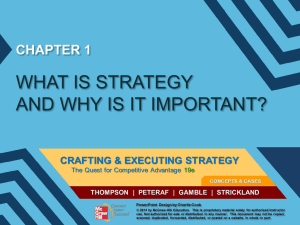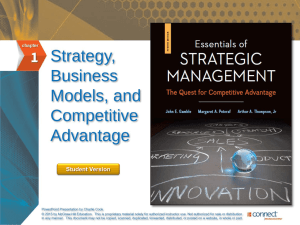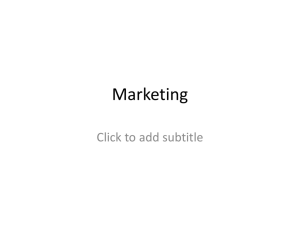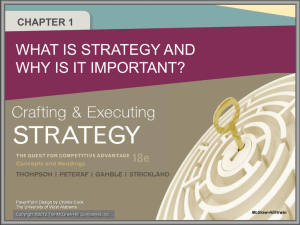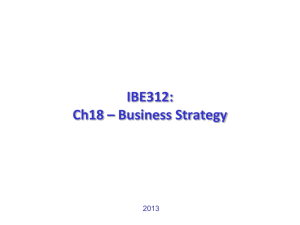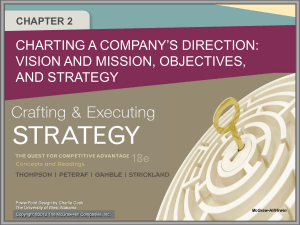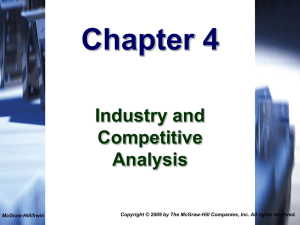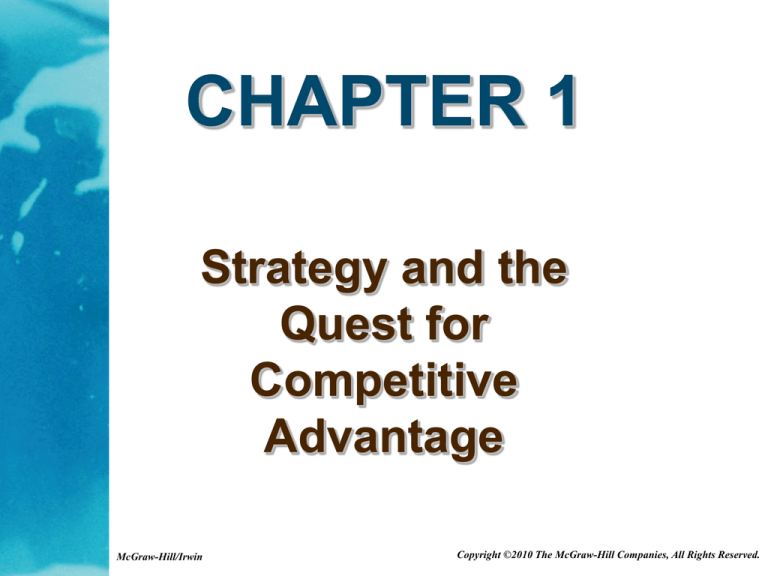
CHAPTER 1
Strategy and the
Quest for
Competitive
Advantage
McGraw-Hill/Irwin
Copyright ©2010 The McGraw-Hill Companies, All Rights Reserved.
Thinking Strategically:
The Three Big Strategic Questions
1. Where are we now?
Current situational analysis
2. Where do we want to go?
Business(es) to be in and
market positions to stake out
Buyer needs and groups to serve
Direction to head
3. How are we going to get there?
A company’s answer to “how will
we get there?” is its strategy
1-2
What Do We Mean By “Strategy?”
Consists of competitive moves and
business approaches used by
managers to run the company
Management’s “action plan” to
Attract and please customers
Compete successfully
Conduct operations
Achieve target levels of
organizational performance
1-3
Answering the Question, “How Are
We Going to Get There?”
How to please customers
How to outcompete rivals
How to manage each
functional piece of the
business (R&D, production,
marketing, HR, finance,
and so on)
How to respond to changing market conditions
How to achieve targeted levels of performance
1-4
Elements of a Company’s Business
Strategy
1-5
McDonald’s Strategy
Key initiatives of McDonald’s
“Plan to Win” Strategy
Improved restaurant operations
Affordable pricing
Wide menu variety and beverage choices
Convenience and expansion of dining
opportunities
Ongoing restaurant reinvestment
1-6
Strategy and Sustainable
Competitive Advantage
A company achieves sustainable
competitive advantage when a
sufficiently large
number of buyers
develop a lasting
preference for its
products/services over
those offered by rivals
1-7
Four Proven Strategic Approaches to
Winning a Sustainable Competitive
Advantage
Developing a cost-based advantage
Creating a differentiation-based
advantage
Focusing on a narrow market niche
Developing competitively valuable
resources and capabilities rivals can’t
easily match, copy, or
trump with substitute
resources
1-8
Competitive Strategy Examples
Strive to be the industry’s low-cost provider
Wal-Mart - distribution capabilities
Southwest Airlines – no frills service
Outcompete with a key differentiating feature
Harley-Davidson – Outlaw image and
distinctive engine sound
Rolex – Top-of-the-line prestige
Amazon.com – Wide selection and
convenience
1-9
Competitive Strategy Examples
Focus on a narrow market niche
Best Buy– Home electronics
eBay – Online auctions
The Weather Channel – Cable TV
Develop competitively important resources or
capabilities not easily imitated by rivals
Fed Ex– Superior distribution capabilities
Ritz-Carlton – Personalized customer
service
1-10
Why Do Strategies Evolve?
A company’s strategy is a work in progress
Changes may be necessary to react to
Shifting market conditions
Changing competitor moves
Evolving customer preferences
Emerging market opportunities
New ideas to improve strategy
Crisis situations
1-11
A Company’s Strategy Is a Blend of
Planned Initiatives and Unplanned
Reactive Adjustments
1-12
The Importance of a Company’s
Business Model
A business model is management’s
blueprint for delivering value to
customers and earning an attractive
profit
Is the strategy capable of
delivering profits?
How will business provide
customers with value and generate
revenues sufficient to cover costs
and produce profits?
What resources are needed to
deliver value to customers?
1-13
Elements of a Business Model
Specifies a customer value proposition (its
approach to satisfying buyer wants and needs
at a price customers will consider a good value)
Develops a profit formula (determining a cost
structure that will allow for acceptable profits
given the pricing tied to its customer value
proposition)
Identifies key resources and processes
necessary to create value and deliver value to
customers
1-14
Tests of a Winning Strategy
GOODNESS OF FIT TEST
How well does strategy fit
the firm’s situation?
COMPETITIVE ADVANTAGE TEST
Does strategy lead to
sustainable competitive
advantage?
PERFORMANCE TEST
Does strategy boost firm
performance?
1-15


